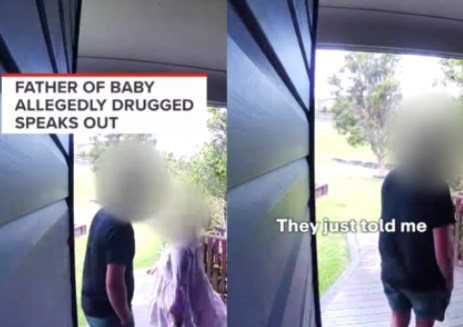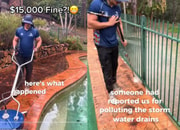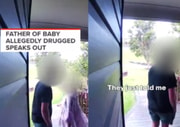
Content warning: This article contains descriptions of alleged child abuse that some readers may find distressing.
The doorbell camera captured a moment no parent should ever have to live through.
A Queensland father, dressed in shorts and a black T-shirt, stands outside his Sunshine Coast home confronting the woman he planned to marry.
His voice trembles as he asks the question that will haunt him forever: ‘Why the f*** would she have Tegretol in her system?’
The woman in the pink and white dress—his partner and the mother of their one-year-old daughter—simply replies that she ‘didn’t know’.
But according to police allegations, she did know, and that chilling detail would unravel a case unlike any Australia has seen before.
What is fabricated or induced illness in children?
For many Australians, particularly those over 60, the term ‘Munchausen syndrome by proxy’ might sound familiar.
In Australia, this condition is now known as ‘fabricated or induced illness by carers’ (FIIC) to separate it from Munchausen syndrome.
Unlike its predecessor, FIIC is legally treated as a form of child or victim abuse rather than a mental health condition.
The condition occurs when a caregiver—usually the child’s mother—fabricates symptoms or induces illness in a dependent child, leading doctors to believe a legitimate medical condition exists.
In extreme cases, the carer may poison or harm the child to prompt unnecessary tests or procedures.
The numbers are sobering.
Studies have shown a mortality rate between six and ten per cent, making it one of the deadliest forms of abuse known.
'When it used to be called Munchausen by proxy, [FIIC] was thought to be this really rare, bizarre form of form of child abuse that you hardly ever saw. I'm not sure that that's the case—I think it's a lot more common than we think it is.'
A case that shocked Australia
In January 2025, Queensland Police arrested a 34-year-old Sunshine Coast woman in what could become Australia’s first major case of this kind.
Between August and October 2024, she allegedly gave her one-year-old daughter several unauthorised prescription drugs—medications meant for conditions the child didn’t have.
All the while, she filmed her daughter’s suffering and posted heart-wrenching clips online to thousands of followers.
The videos were paired with a crowdfunding campaign that raised $60,000, supposedly for the baby’s medical bills.
Police allege the baby underwent two unnecessary brain surgeries as a result.
The father described the ordeal with visible pain: ‘She almost died several times, several cardiac arrests, several peri arrests.’
Hospital staff finally intervened in October 2024, raising concerns that led to the woman’s arrest months later.
How social media changed everything
This Queensland case marks a chilling evolution of FIIC.
Where once perpetrators sought sympathy from family or doctors, today’s abusers can broadcast their victim’s suffering to thousands through social media and crowdfunding sites.
Prosecutor Jack Scott told the court the woman ‘filmed and posted videos of the child’ and that ‘the content produced exploited the child and was used to entice monetary donations and online followers.’
Court documents further allege she moved cameras during medical tests to avoid being caught while administering unauthorised medication through the child’s feeding tube.
This digital layer of exploitation adds new dangers—and new questions about how online platforms should respond.
The forgotten victim: Partners and family members
Beyond the immediate horror lies a quieter tragedy—the collateral damage to innocent family members.
The Queensland father, who cannot be named for legal reasons, has faced suspicion, social backlash, and financial hardship since the allegations surfaced.
‘I’ve lost friends, I’ve lost family members, I’ve lost multiple jobs because I’ve been accused of something that I didn’t do,’ he told A Current Affair.
‘I’ve lost my self worth. I’m most likely going to lose my car.’
His other children have been removed from his care, though he is allowed supervised visits.
When asked if he hoped his former partner would face prison, his answer was blunt: ‘Hope so.’
Warning signs Australian doctors look for
According to forensic paediatricians, FIIC should be considered when three key criteria are met: the child appears to be receiving excessive health care
The child appears to be presented as more unwell or impaired than it actually is
It appears to be the parent that is driving that
How Australian hospitals detect FIIC
Australian hospitals have become increasingly skilled at identifying FIIC.
After seeing what they believe is a rise in suspected cases, experts suggest the condition can now be caught earlier.
Greater awareness is a positive step—but the question remains whether we are only seeing the tip of the iceberg.
Many paediatricians will, at some point in their careers, care for a child suspected of having FIIC.
This growing recognition has led to better training and stronger reporting protocols across hospitals.
In the Sunshine Coast case, it was the vigilance of hospital staff that prevented further harm—ultimately leading to the mother’s arrest.
Understanding the complexity
Over time, medical understanding of this condition has evolved.
The focus has shifted away from the perpetrator’s psychological motives to the harm caused to the child.
Terms like Munchausen Syndrome by Proxy, Fabricated Disorder Imposed on Another, and Paediatric Condition Falsified have all reflected this shift—from explaining the abuser’s mindset to protecting the victim.
This reframing helps doctors and authorities act faster, focusing on child safety rather than the complexities of intent.
The legal journey ahead
The Queensland woman remains on bail as the case continues through the courts.
Her solicitor has requested extra time to hire a medical assistant due to the case’s complexity, while prosecutors await DNA results from medication found at the hospital.
If convicted, the case could set new legal precedents for prosecuting FIIC cases involving social media and online fundraising.
What This Means For You
The Queensland father is slowly rebuilding his life as his daughter recovers in care.
‘She’s been looked after by good people,’ he said. ‘She’s come a long way. She still knows who Daddy is.’
Understanding FIIC is not just about being informed—it’s about being alert.
Whether you are a parent, grandparent, or close family friend, recognising unusual patterns in a child’s medical care, online campaigns, or sudden health crises can make a crucial difference.
Awareness, vigilance, and knowing how to seek help can protect both children and entire families from devastating consequences.
If the Queensland FIIC case left you shaken, there are other real-life instances that highlight how complex and devastating fabricated illness can be.
One case in South Australia involved a couple who allegedly fabricated their child’s illness to gain sympathy and financial support, showing how these situations can unfold in heartbreaking ways.
Exploring similar stories can help provide context and a deeper understanding of the warning signs and consequences of such abuse.
Read more: Authorities arrest one couple for bizarre form of child abuse
Dad reveals moment he discovered baby daughter allegedly drugged by mum — Reports on a Queensland father confronting his partner after discovering alleged administration of prescription drugs to their baby.
https://www.news.com.au/lifestyle/r...m/news-story/ea67c87fdba7280ef1d044ff01830b09
Munchausen syndrome | Better Health Channel — Explains that in Australia, Munchausen by proxy is now known as ‘fabricated or induced illness by carers’ (FIIC) and treated as a form of child abuse rather than a mental health condition.
https://www.betterhealth.vic.gov.au/health/conditionsandtreatments/munchausen-syndrome
"Munchausen by proxy syndrome": not only pathological parenting but also problematic doctoring? | The Medical Journal of Australia — Describes how FIIC occurs when a caregiver fabricates or induces illness in a dependent child, misleading doctors into believing a genuine medical condition exists.
https://www.mja.com.au/journal/2003...-only-pathological-parenting-also-problematic
Munchausen syndrome | Better Health Channel — Notes that in cases of FIIC, a caregiver may deliberately harm a child to prompt unnecessary medical tests or procedures.
https://www.betterhealth.vic.gov.au/health/conditionsandtreatments/munchausen-syndrome
Factitious disorder imposed on another—Wikipedia — Provides statistics showing a mortality rate between six and ten per cent for FIIC, highlighting its high lethality.
https://en.wikipedia.org/wiki/Factitious_disorder_imposed_on_another
Munchausens by proxy not a ‘rare engima’—Medical Republic — Lists three key warning signs Australian doctors look for when suspecting FIIC, including excessive healthcare, overstated illness, and parent-driven medical attention.
https://www.medicalrepublic.com.au/munchausens-by-proxy-not-a-rare-engima/5842
Munchausens by proxy not a ‘rare engima’—Medical Republic — Discusses how earlier recognition of suspected FIIC cases is possible due to increased referrals and awareness.
https://www.medicalrepublic.com.au/munchausens-by-proxy-not-a-rare-engima/5842
Fabricated or induced illness in children: A guide for Australian health‐care practitioners—Tully—2021—Journal of Paediatrics and Child Health — Notes that FIIC cases may only be the tip of the iceberg, emphasizing the importance of vigilance in early detection.
https://onlinelibrary.wiley.com/doi/10.1111/jpc.15663
Fabricated or induced illness in children: A guide for Australian health‐care practitioners—Tully—2021—Journal of Paediatrics and Child Health — Explains that many paediatricians will encounter children suspected of having FIIC during their careers, leading to better training and protocols.
https://onlinelibrary.wiley.com/doi/10.1111/jpc.15663
Fabricated or induced illness in children: A guide for Australian health‐care practitioners—Tully—2021—Journal of Paediatrics and Child Health — Highlights the shift from focusing on the caregiver’s motivation to prioritising the harm caused to the child.
https://onlinelibrary.wiley.com/doi/10.1111/jpc.15663
How should social media and crowdfunding platforms handle cases where children are exploited for sympathy or money?







